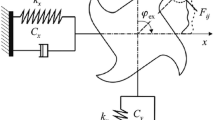Abstract
During the machining of mechanical parts, structural damages such as cracks can appear on the finished surface, consequently, the measured cutting forces being perturbed. It is difficult to detect directly such damages starting from the measured signals because they are always mixed with the measuring noise. In this paper, a method based on the wavelet multiresolution analysis is applied to extract the required information relating to the existence of structural damages in a disk using the cutting force signals measured by a Kistler dynamometer during the disk machining. In order to simulate the structural damage, a longitudinal crack is voluntarily created on the cylindrical surface of the disk. Since periodic impacts are produced each time the cutting tool comes into contact with the structural damage, an optimized wavelet multiresolution analysis is used as a filtering and a denoising tool. The experimental results show the validity of this method within the detection of single and multiple defects created on the disk surface during the machining processes.
Similar content being viewed by others
References
Salio M, Berruti T, De Poli G (2006) Prediction of residual stress distribution after turning in turbine disks. Int J Mech Sci 48:976–984
Mata F, Beamud E, Hanafi I, Khamlichi A, Jabbouri A, Bezzazi M (2010) Multiple regression prediction model for cutting forces in turning carbon-reinforced PEEK CF30. Adv Mater Sci Eng 2010:1–7
Kaymakci M, Kilic ZM, Altintas Y (2012) Unified cutting force model for turning, boring, drilling and milling operations. Int J Mach Tools Manuf 54–55:34–45
Akyildiz HK, Livatyali H (2011) Prediction and experimental analysis of cutting forces during machining of precision external threads. Mach Sci Technol 15:485–506
Magnevall M, Lundblad M, Ahlin K, Broman G (2011) High frequency measurements of cutting forces in milling by inverse filtering. Mach Sci Technol 15:147–166
Yan R, Gao RX, Chen X (2014) Wavelets for faults diagnosis of rotary machines: a review with applications. Sig Proc 96:1–15
Sun Q, Tang Y (2002) Singularity analysis using continuous wavelet transform for bearing fault diagnosis. Mech Syst Signal Process 16–6:1025–1041
Nikolaou NG, Antoniadis IA (2002) Demodulation of vibration signals generated by defects in rolling element bearings using complex shifted Morlet wavelets. Mech Syst Signal Process 16–4:677–694
Peter W (2000) Wavelets analysis. A flexible and efficient fault diagnostic method for rolling element bearing. 7th Int Cong Sound and Vib 507-514, Germany 4-7 July 2000
Boltežar M, Simonovski I, Furlan M (2003) Fault detection in DC electro motors using the continuous wavelet transform. Meccanica 38:251–264
Yang DM, Stronach AF, Mac Connell P (2003) The application of advanced signal processing techniques to induction motor bearing condition diagnosis. Meccanica 38:297–308
Mallat S (1989) A theory for multiresolution signal decomposition: the wavelet representation. IEEE Trans Anal Mach Intel 11–7:674–693
Brabhakar S, Mohanty AR, Sekhar AS (2002) Application of discrete wavelet transform for detection of ball bearings race faults. Tribol Int 35:793–800
Chinmaya K, Mohanty AR (2006) Monitoring gear vibrations through motor current signature analysis and wavelet transform. Mech Syst Signal Process 20–1:158–187
Djebala A, Ouelaa N, Hamzaoui N (2008) Detection of rolling bearing defects using discrete wavelet analysis. Meccanica 43–3:339–348
Djebala A, Ouelaa N, Benchaabane C, Laefer DF (2012) Application of the wavelet multiresolution analysis and Hilbert transform for the prediction of gear tooth defects. Meccanica 47–7:1601–16121
Author information
Authors and Affiliations
Corresponding author
Rights and permissions
About this article
Cite this article
Khechana, M., Djamaa, M.C., Djebala, A. et al. Identification of structural damage in the turning process of a disk based on the analysis of cutting force signals. Int J Adv Manuf Technol 80, 1363–1368 (2015). https://doi.org/10.1007/s00170-015-7110-6
Received:
Accepted:
Published:
Issue Date:
DOI: https://doi.org/10.1007/s00170-015-7110-6




